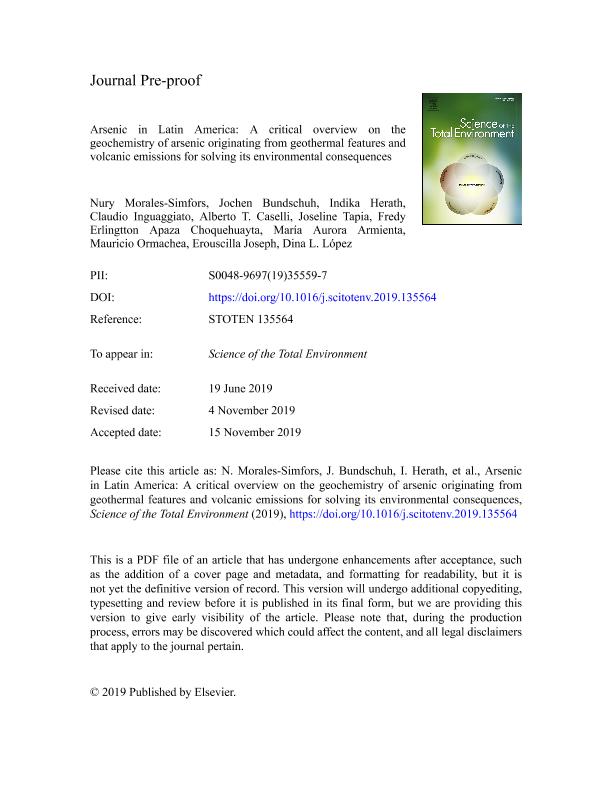Mostrar el registro sencillo del ítem
dc.contributor.author
Morales Simfors, Nury
dc.contributor.author
Bundschuh, Jochen
dc.contributor.author
Herath, Indika
dc.contributor.author
Inguaggiato, Claudio

dc.contributor.author
Caselli, Alberto Tomás

dc.contributor.author
Tapia, Joseline
dc.contributor.author
Choquehuayta, Fredy Erlingtton Apaza
dc.contributor.author
Armienta, María Aurora
dc.contributor.author
Ormachea, Mauricio
dc.contributor.author
Joseph, Erouscilla
dc.contributor.author
López, Dina L.
dc.date.available
2020-12-01T11:24:58Z
dc.date.issued
2020-05
dc.identifier.citation
Morales Simfors, Nury; Bundschuh, Jochen; Herath, Indika; Inguaggiato, Claudio; Caselli, Alberto Tomás; et al.; Arsenic in Latin America: A critical overview on the geochemistry of arsenic originating from geothermal features and volcanic emissions for solving its environmental consequences; Elsevier; Science of the Total Environment; 10; 4; 5-2020; 456-479
dc.identifier.issn
0048-9697
dc.identifier.uri
http://hdl.handle.net/11336/119420
dc.description.abstract
Geothermal fluids and volcanic emissions are important sources of arsenic (As), resulting in elevated concentrations of As in ground-, surface-water and soil, which may adversely affect the environment. Arsenic originating from geothermal features and volcanic activities is common in Latin America forming a serious threat to the livelihoods of millions of people. This review attempts to provide a critical overview of the geochemistry of As originating from these sources in Latin America to understand what information exists about and what future research needs to be undertaken. This study evaluated 15 countries in Latin America. In total, 423 sites were characterized with As originating from geothermal sources, mostly related to present volcanic activity (0.001 < As<73 mg/L, mean: 36.5 mg/L) and the transboundary Guarani Aquifer System (0.001 < As<0.114 mg/L, mean: 0.06 mg/L). Many of the geothermal systems and volcanoes discussed in this study are close to densely populated cities, including Bogota, Managua, San José, Guatemala City and Mexico City, where total As concentrations in natural ground- and surface- water exceed the safe drinking water guideline of 0.01 mg/L, recommended by the World Health Organization (WHO). However, the wide geographical occurrence of As in geothermal fluids and volcanic emissions of this region is by far not fully understood, so that development of geographical maps based on geographic information system (GIS) is an urgent necessity to understand the real nature of the problem. The assessment of environmental risks and the potential impacts on human health both inadequate and scarce and hence, these gaps need to be addressed by future research. The present holistic assessment of As originating from geothermal features and volcanic emissions would be a driving force to formulate a plan for establishing a sustainable As mitigation in vulnerable areas of Latin America in the near future. An assessment of the geochemistry, mobility and distribution of As would augment the effectiveness of the plan.
dc.format
application/pdf
dc.language.iso
eng
dc.publisher
Elsevier

dc.rights
info:eu-repo/semantics/openAccess
dc.rights.uri
https://creativecommons.org/licenses/by-nc-nd/2.5/ar/
dc.subject
ENVIRONMENTAL IMPACTS
dc.subject
GEOCHEMISTRY
dc.subject
GEOGENIC CONTAMINANTS
dc.subject
GEOTHERMAL SYSTEMS
dc.subject
VOLCANIC EMISSIONS
dc.subject
WATER RESOURCES
dc.subject.classification
Geoquímica y Geofísica

dc.subject.classification
Ciencias de la Tierra y relacionadas con el Medio Ambiente

dc.subject.classification
CIENCIAS NATURALES Y EXACTAS

dc.title
Arsenic in Latin America: A critical overview on the geochemistry of arsenic originating from geothermal features and volcanic emissions for solving its environmental consequences
dc.type
info:eu-repo/semantics/article
dc.type
info:ar-repo/semantics/artículo
dc.type
info:eu-repo/semantics/publishedVersion
dc.date.updated
2020-11-19T21:34:32Z
dc.journal.volume
10
dc.journal.number
4
dc.journal.pagination
456-479
dc.journal.pais
Países Bajos

dc.journal.ciudad
Amsterdam
dc.description.fil
Fil: Morales Simfors, Nury. Research Institutes of Sweden; Suecia. University of Southern Queensland; Australia. Unesco; Australia
dc.description.fil
Fil: Bundschuh, Jochen. University of Southern Queensland; Australia. Unesco; Australia
dc.description.fil
Fil: Herath, Indika. University of Southern Queensland; Australia. Unesco; Australia
dc.description.fil
Fil: Inguaggiato, Claudio. Centro de Investigación Científica y de Educación Superior de Ensenada. Departamento de Geología; México
dc.description.fil
Fil: Caselli, Alberto Tomás. Consejo Nacional de Investigaciones Científicas y Técnicas. Centro Científico Tecnológico Conicet - Patagonia Norte. Instituto de Investigación en Paleobiología y Geología; Argentina. Universidad Nacional de Río Negro. Sede Alto Valle. Instituto de Investigaciones en Paleobiología y Geología; Argentina
dc.description.fil
Fil: Tapia, Joseline. Universidad de Santo Tomás. Facultad de Ingeniería. Escuela de Geología; Chile
dc.description.fil
Fil: Choquehuayta, Fredy Erlingtton Apaza. Instituto Geológico, Minero y Metalúrgico; Perú
dc.description.fil
Fil: Armienta, María Aurora. Universidad Nacional Autónoma de México; México
dc.description.fil
Fil: Ormachea, Mauricio. Universidad Mayor de San Andrés; Bolivia
dc.description.fil
Fil: Joseph, Erouscilla. University of West Indies; Trinidad y Tobago
dc.description.fil
Fil: López, Dina L.. Ohio University; Estados Unidos
dc.journal.title
Science of the Total Environment

dc.relation.alternativeid
info:eu-repo/semantics/altIdentifier/doi/http://dx.doi.org/10.1016/j.scitotenv.2019.135564
Archivos asociados
